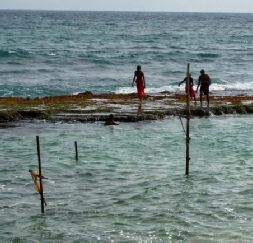© 2023 Dr Margaret Sheppard
Fishing
Fish abound in the seas that surround Sri Lanka and are also found widely inland in the rivers, lagoons, reservoirs and irrigation channels. Fish is widely eaten as the preferred protein by the majority of the population. Thus fishing is an important product. Not only are there sea and inland fishermen who derive incomes from fishing, but fishing also supports many other subsidiary occupations such as boat builders and repairers, net makers, traders and merchants to name but a few.
However much of the fishing is seasonal. The seas surrounding much of the island are always rough, but particularly so during the monsoons when the fleet of small boats (orus/catarmarans and fibre glass outboards) cannot go out. Fishing families therefore need to make enough during the fishing seasons to tide them through the monsoon months when there will be very few fishing days and thus no income from fishing. Many fishermen have other occupations as well.
There are now several types of fishing boats. In the early 1990s, the majority were orus (catamarans) typically crewed by one or two crew. Larger catamarans with up to five or six crew are found on fishing beaches such as Weligama whereas many of those further South that operate off Dikwella Beach are crewed by a single fisherman. Around Negombo and off the North Coast on the Jaffna Peninsula these often have a mast and sail. Originally these were made of wood and although the floats are still often fashioned from tree trunks, the boats nowadays are usually of fibreglass.
The much larger so-
The fishing organisation is complicated -
When the catch is landed, it is shared out in varying proportions between the boat owner, the owner of the net, the crew and the various hangers-
Fish merchants congregate on the beach or at the fishing harbours in the early morning as the boats come in and the catch is customarily auctioned from the boat. Nowadays in the era of mobile phone communication, the crew of a returning boat will call up the traders to notify their approach and the composition of the catch they will be landing.
Private individuals also congregate on the beach to buy their daily fish supply for their families.
Around many of the fishing beaches where the smaller boats are beached, fishermen have their huts where they store their equipment such as nets and outboard engines etc. The fishermen operating from a particular beach are typically formed into a Fishermen’s Society and they elect a Fishermen’s Leader. Some of the larger societies e.g. at Godawaya, run their own small banks that advance loans to their members and where fishermen can easily safely bank their profits from a catch, These savings accounts are used to make loans but also pay interest to the account holders.









Seas surrounding the island are often rough especially during the monsoon seasons, therefore on many days fishing is impossible. Thus fishermen typically have other occupations as well. Others may fish the other side of the island as the monsoon and stormy season is from approx: April to November on the Western side and November to April on the Eastern side of the island. They need to obtain permission from the appropriate Fishermen’s Organisations to fish their own boats or they may crew for these boats on the other side of the island.
Views of Sri Lankan beaches. Local fishermen pull their boats up above the tide lines when not fishing, On this beach, typical of many, they fish from a number of types -
You Tube Video Links:
Oru Fishing Canoe, surfing onto Dickwella Beach, Southern Sri Lanka
https://youtu.be/yqqwO4u48vg
Sri Lankan Fishermen, Godawaya, after the Tsunami
https://youtu.be/kAOkyanxLQ8